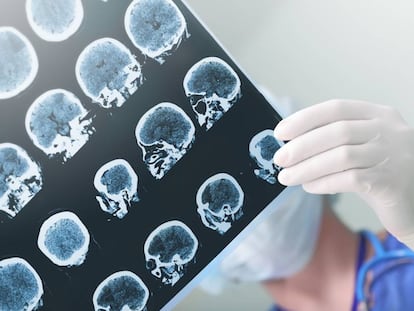Can strokes be prevented?
Strokes can be classified into two main categories. A large part of them can be prevented with a healthy lifestyle

Yes, strokes can be (partly) prevented. Strokes are caused by a failure in cerebral blood circulation. We classify them into two types: ischemic and hemorrhagic.
An ischemic stroke is caused by an occlusion (blockage) of the passage of blood. Generally, there’s thrombus that clogs a cerebral artery. This triggers a series of pathophysiological mechanisms that lead to the death of cells that should be receiving this blood circulation. Approximately 80% of strokes are ischemic — this is the most frequent kind.
Hemorrhagic strokes, meanwhile, account for the remaining 20% of cases. They occur due to bleeding in the brain, following the rupture of a blood vessel in the cerebral artery. In this case, there are also some pathophysiological mechanisms that — as occurs with ischemic strokes — end up causing the death of the brain cells that should be receiving blood.
A stroke is a disabling disease that, in most cases, affects adults. However, on occasion, there are also pediatric strokes. But, in adults, strokes are the principal cause of acquired disabilities.
As I noted earlier, strokes, in part, can be prevented. When we talk about ischemic strokes, there are two main groups of causes. The first are related to cardiovascular and cerebrovascular risk factors — what are known as “shared vascular risk factors” — including hypertension, diabetes, dyslipidemia (the alteration of levels of fat, cholesterol and triglycerides in the blood), smoking and, according to certain studies, obesity. These vascular risk factors cause blood vessels to harden or accumulate atheromatous plaque, which essentially cause the vessels to close, or an embolism to occur (when a part of that atheromatous plaque detaches and obstructs an artery). This is the most common cause of ischemic strokes.
The second-most frequent cause of these types of strokes is when they have cardioembolic origins. That is, when heart disease causes an embolism, which subsequently travels through the bloodstream to the brain and causes an ischemic stroke.
In the first case that I discuss, if certain pathologies are prevented — hypertension, diabetes, cholesterol, smoking, obesity — the possible occurrence of a stroke is prevented at the same time. In the case of cardioembolic ischemic stroke, however, what’s required is the prevention of embolisms caused by heart disease. Basically, this happens when there’s an arrhythmia (an irregular heartbeat). If the arrhythmia is treated with appropriate drugs — most often anticoagulants — you can prevent an embolism and, therefore, also prevent a possible stroke.
As for hemorrhagic strokes, vascular risk factors — such as hypertension — do play a role. But there are other causes, such as the accumulation of abnormal proteins. For instance, cerebral amyloid angiopathy (CAA) is a condition in which proteins build up in the arteries in the brain. Something like this is more difficult to prevent. However, the treatment of hypertension can prevent both ischemic strokes and hemorrhagic strokes.
A stroke is a very serious pathology. In many developed countries, before the pandemic, it was the leading cause of death among women and the third among men. Strokes are also a major cause of disabilities: the leading cause of acquired disabilities, as well as the second-leading cause of vascular dementia.
While strokes can occur in children, this is very rare. In general, the risk of suffering a stroke increases with age.
Sign up for our weekly newsletter to get more English-language news coverage from EL PAÍS USA Edition
Tu suscripción se está usando en otro dispositivo
¿Quieres añadir otro usuario a tu suscripción?
Si continúas leyendo en este dispositivo, no se podrá leer en el otro.
FlechaTu suscripción se está usando en otro dispositivo y solo puedes acceder a EL PAÍS desde un dispositivo a la vez.
Si quieres compartir tu cuenta, cambia tu suscripción a la modalidad Premium, así podrás añadir otro usuario. Cada uno accederá con su propia cuenta de email, lo que os permitirá personalizar vuestra experiencia en EL PAÍS.
¿Tienes una suscripción de empresa? Accede aquí para contratar más cuentas.
En el caso de no saber quién está usando tu cuenta, te recomendamos cambiar tu contraseña aquí.
Si decides continuar compartiendo tu cuenta, este mensaje se mostrará en tu dispositivo y en el de la otra persona que está usando tu cuenta de forma indefinida, afectando a tu experiencia de lectura. Puedes consultar aquí los términos y condiciones de la suscripción digital.
More information
Últimas noticias
From Andorra to Gibraltar, a black market for Ozempic exploits its success: ‘They’re the most sought-after products in the world’
Magnets in their heads: How some animals guide themselves using the Earth’s magnetic field
From Hungary’s Orbán to Chile’s Kast: How Trump helps turbo charge the far right
The brief rise and retreat of Generation Z in Mexico
Most viewed
- Why we lost the habit of sleeping in two segments and how that changed our sense of time
- Trump’s obsession with putting his name on everything is unprecedented in the United States
- Charles Dubouloz, mountaineering star, retires at 36 with a farewell tour inspired by Walter Bonatti
- The Florida Keys tourist paradise is besieged by immigration agents: ‘We’ve never seen anything like this’
- Living in a motorhome due to soaring housing prices in Madrid: ‘I got used to it quickly, but I don’t idealize it’










































